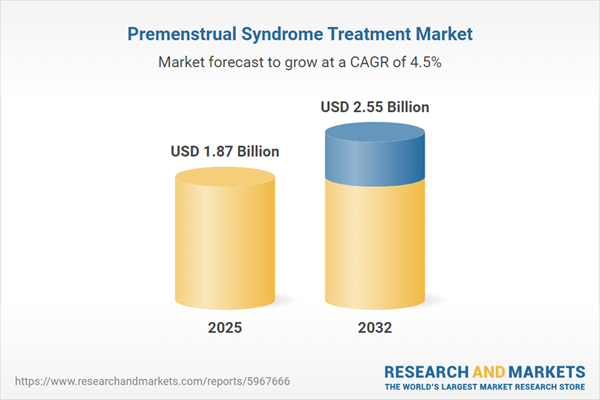Speak directly to the analyst to clarify any post sales queries you may have.
Senior decision-makers face an evolving market landscape in premenstrual syndrome treatment, with regulatory shifts and digital transformation accelerating change. To maintain growth and operational agility, organizations must embrace integrated, patient-centered models and adopt resilient business strategies anchored in both innovation and compliance.
Market Snapshot: Premenstrual Syndrome Treatment Market Overview
The premenstrual syndrome treatment market is experiencing growth due to ongoing advancements in women’s health solutions and the rise of digital healthcare platforms. Strategic initiatives centered on patient well-being are reshaping competitive dynamics, as companies align clinical practices with evolving patient and regulatory demands. The expansion of digital service models and a widened focus on patient preferences influence organizational strategies, compelling continuous adaptation. This environment prioritizes flexibility and responsiveness to changing compliance standards and market needs, ultimately redefining clinical and commercial priorities across global segments.
Scope & Segmentation: Market Structures and Opportunities
- Treatment Types: Spanning from cognitive-behavioral therapies and lifestyle modifications to oral contraceptives, SSRIs, and GABA analogs, the landscape enables providers to design tailored protocols addressing a broad range of patient experiences.
- End Users: Solutions are applied in home care, hospitals, and specialized clinics, allowing organizations to better meet patient needs and refine care delivery for diverse populations.
- Product Forms: Capsules, tablets, and liquids offer flexibility for acute or ongoing interventions, supporting tailored approaches in institutional and home-based settings.
- Regional Coverage: The market includes the Americas, EMEA, and Asia-Pacific regions. Major territories such as the United States, China, India, and Brazil each bring unique regulatory and market access challenges, requiring region-specific strategies for entry and compliance.
- Company Analysis: Major industry participants include Bayer AG, Pfizer Inc., Johnson & Johnson Services, and Eli Lilly and Company. These firms operate across pharmaceutical, nutraceutical, and digital health, leveraging innovation and strategic partnerships for competitive positioning.
Key Takeaways for Senior Decision-Makers
- Digital health technologies are increasing patient engagement and supporting seamless care in both facility-based and remote environments, strengthening adherence and scalability.
- Combining pharmacological and non-pharmacological therapies builds flexibility into intervention plans, allowing organizations to address a wider spectrum of patient needs and reinforce commercial resilience.
- Offering capsules, tablets, and liquids gives providers more options to customize delivery, facilitating improvements in compliance management and patient satisfaction across settings.
- Regularly reviewing and updating compliance measures is essential for navigating shifting regional regulations, supporting organizational reliability and risk mitigation in dynamic policy landscapes.
- Collaboration across pharmaceutical, nutraceutical, and digital health domains accelerates the development lifecycle, enabling faster adaptation to emerging market trends and service demands.
- Consistent engagement with suppliers, clinicians, and patient advocacy groups helps strengthen value chains, enhancing solution reliability and optimizing delivery effectiveness.
Tariff Impact: Navigating Policy and Supply Chain Shifts
Recent changes in United States tariff policies affecting pharmaceutical and nutritional imports have directly influenced operational priorities across the sector. To address these new regulatory uncertainties, leading market participants are channeling resources into local manufacturing investments and adopting risk-sharing models. These strategies are designed to buffer against supply chain volatility, protect operational continuity, and support sustained growth even in unpredictable policy environments.
Market Methodology & Data Sources
This analysis draws from executive interviews, extensive secondary research, and comprehensive reviews of clinical, regulatory, and market documents. Engagement with experts in healthcare and logistics ensures findings are robust and credible. Regular surveys further sharpen trend analysis and inform actionable recommendations for market participants.
Why This Report Matters
- Enables clear understanding of technology adoption and operational change, informing strategic development and investment assessment for evolving market realities.
- Delivers actionable guidance about regional risk and shifting regulations, reinforcing preparation for supply chain and trade policy adjustments.
- Supports benchmarking and digital transformation evaluations, enhancing resource allocation and partnership strategies for ongoing competitiveness.
Conclusion
Success in the premenstrual syndrome treatment market relies on advancing digital capacity, maintaining regulatory adaptability, and prioritizing patient-focused strategies. Together, these approaches help organizations build resilience and achieve sustainable growth.
Additional Product Information:
- Purchase of this report includes 1 year online access with quarterly updates.
- This report can be updated on request. Please contact our Customer Experience team using the Ask a Question widget on our website.
Table of Contents
3. Executive Summary
4. Market Overview
7. Cumulative Impact of Artificial Intelligence 2025
Companies Mentioned
The companies profiled in this Premenstrual Syndrome Treatment market report include:- Bayer AG
- Pfizer Inc.
- Johnson & Johnson Services, Inc.
- Eli Lilly and Company
- GlaxoSmithKline PLC
- Teva Pharmaceutical Industries Ltd.
- Viatris Inc.
- Novartis AG
- Sanofi S.A.
- Sun Pharmaceutical Industries Ltd.
Table Information
| Report Attribute | Details |
|---|---|
| No. of Pages | 186 |
| Published | November 2025 |
| Forecast Period | 2025 - 2032 |
| Estimated Market Value ( USD | $ 1.87 Billion |
| Forecasted Market Value ( USD | $ 2.55 Billion |
| Compound Annual Growth Rate | 4.4% |
| Regions Covered | Global |
| No. of Companies Mentioned | 11 |









